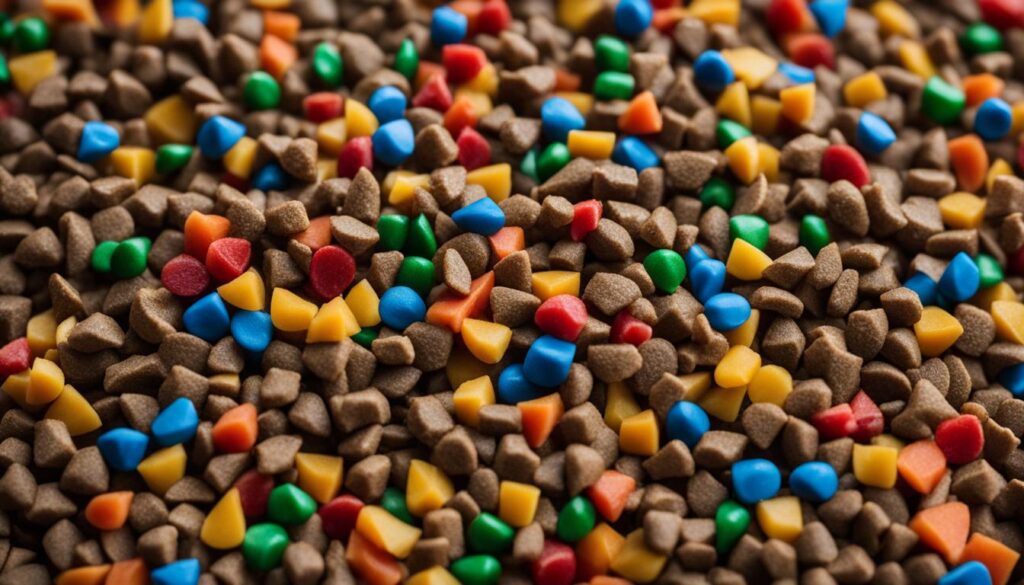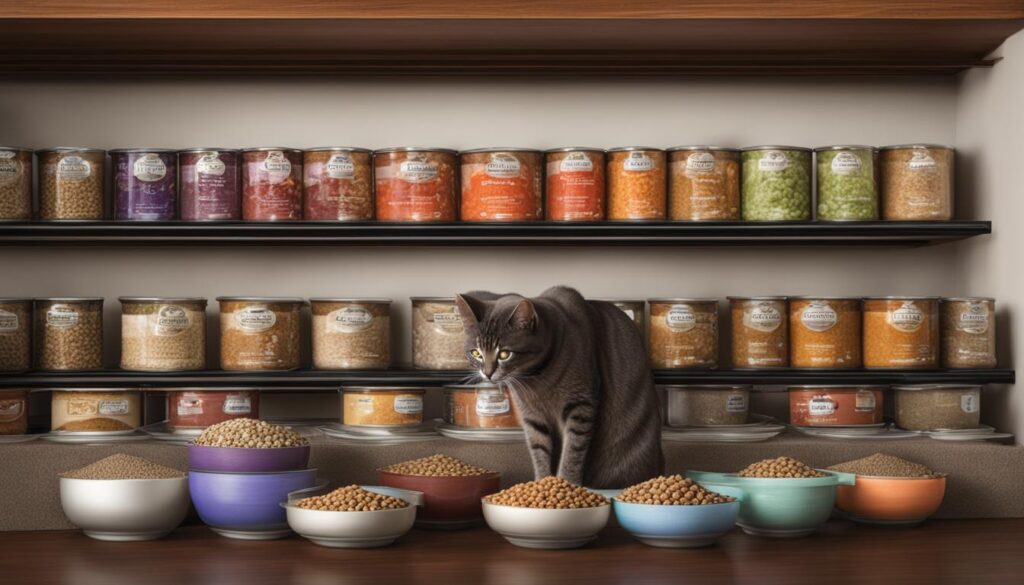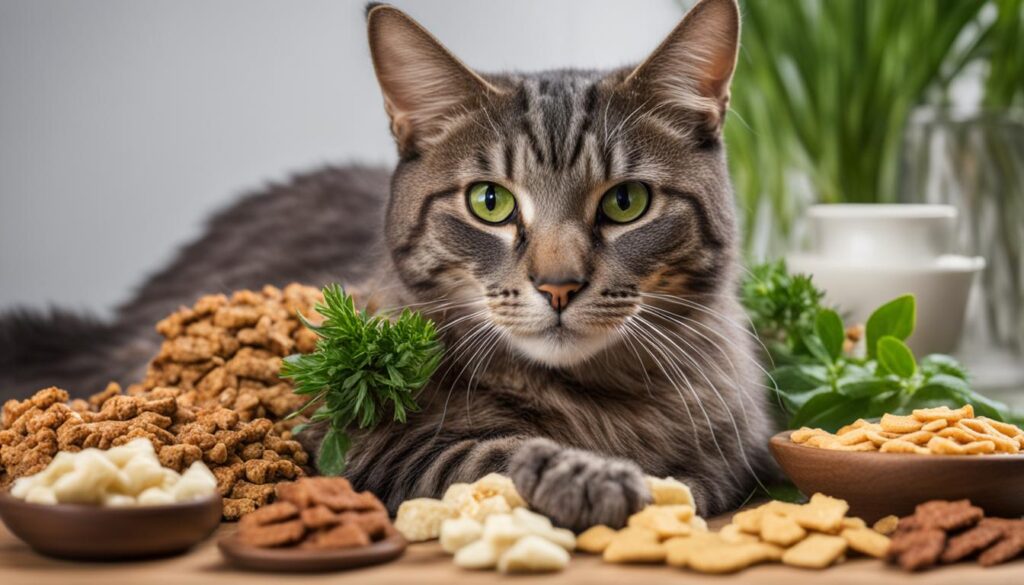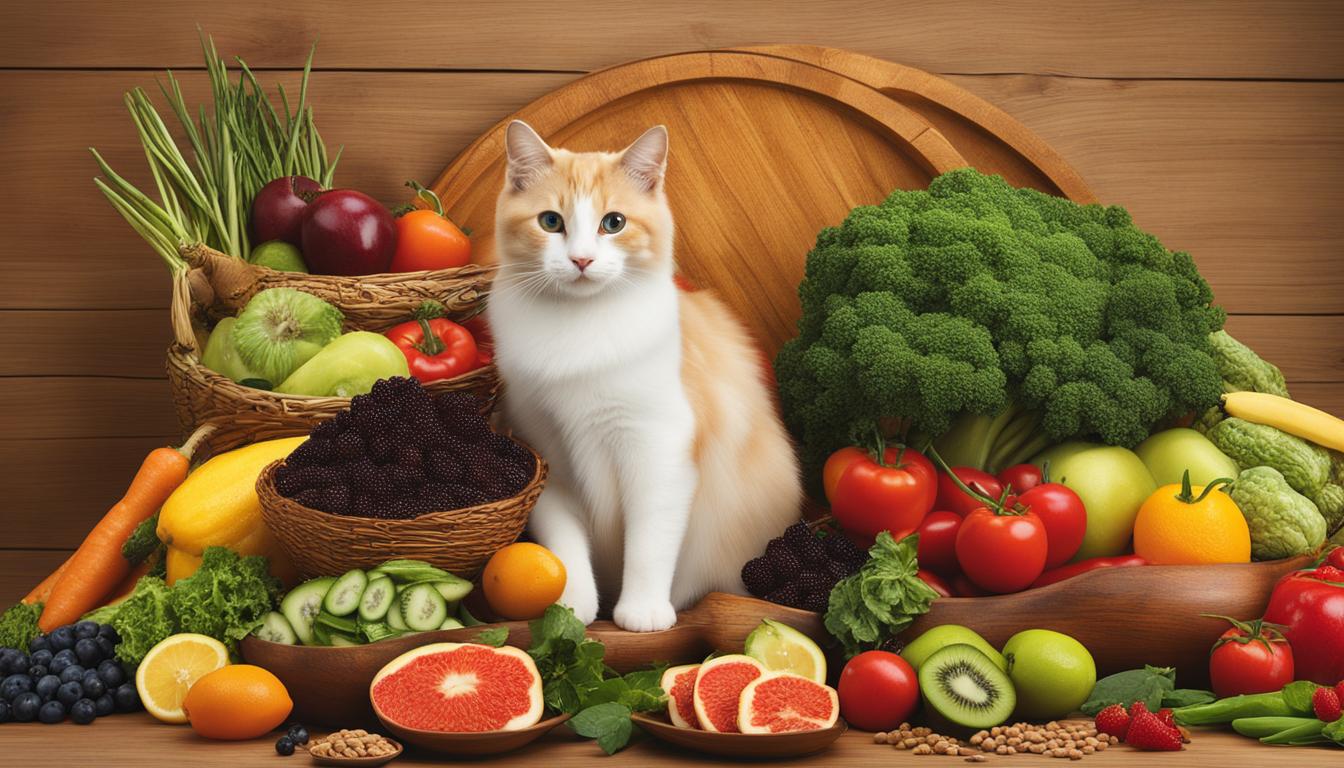Cats and Their Nutritional Needs: What Makes a Healthy Feline Diet
{“targetCountry”: “US”}
Welcome to our guide on cat nutrition and feline diets. As cat owners, we want to provide the best care for our furry friends, and nutrition plays a crucial role in their overall health and well-being. Understanding what makes a healthy feline diet is key to ensuring our cats thrive.
Cats are unique creatures with specific nutritional requirements. As obligate carnivores, they rely on nutrients found in animal products to meet their dietary needs. They require a diet that is high in protein, moderate in fat, and low in carbohydrates. In addition to protein, cats need essential vitamins, minerals, fatty acids, and amino acids to support their overall health.
When it comes to feeding our cats, there are different options available, including commercial cat foods and homemade diets. Commercial cat foods come in various forms, such as dry, semi-moist, and canned, each with its own set of advantages and considerations. It’s important to choose high-quality commercial cat foods that meet the nutritional standards set by experts.
In this guide, we will explore the necessary nutrients for cats, the types of commercial cat foods available, and how to choose the right cat food for your feline companion. We will also discuss homemade diets, treats, feeding guidelines for different life stages, and other considerations to keep in mind when it comes to cat nutrition.
Key Takeaways:
- Cats are obligate carnivores, meaning they rely on nutrients found in animal products for optimal health.
- They require a diet high in protein, moderate in fat, and low in carbohydrates.
- Commercial cat foods come in different forms, including dry, semi-moist, and canned, each with its pros and cons.
- Homemade diets are not recommended unless prescribed by a veterinarian for specific medical purposes.
- Treats should be given sparingly and should not exceed 10-15% of a cat’s daily caloric intake.
Necessary Nutrients for Cats
Cats require a variety of essential nutrients to maintain their overall health and well-being. These nutrients are crucial for their growth, energy, immune function, and the overall function of their organs and systems. Let’s explore the key nutrients that are vital for cats:
1. Protein
Protein is an essential component of a cat’s diet and plays a critical role in their overall health. It is necessary for the development and maintenance of muscle mass, skin and coat health, and the production of important enzymes and hormones. Cats have unique amino acid requirements, particularly for taurine, arginine, and methionine, which they can only obtain through animal protein.
2. Vitamins and Minerals
Vitamins and minerals are essential for cats as they support various bodily functions. Cats require vitamins like vitamin A, D, E, K, and B vitamins to maintain healthy eyes, bones, immune function, and overall well-being. Minerals such as calcium, phosphorus, and potassium are essential for normal growth, nerve function, and maintaining healthy teeth and bones.
3. Fatty Acids
Fatty acids, specifically omega-3 and omega-6 fatty acids, are necessary for cats to maintain healthy skin and coat. These fatty acids also support a healthy immune system and contribute to overall cardiovascular health.
Summary
In summary, cats have specific nutritional requirements to thrive and maintain optimal health. Essential nutrients such as protein, vitamins, minerals, and fatty acids are vital for their growth, energy, and overall well-being. Providing your cat with a balanced and nutritionally complete diet is crucial to ensure they receive all the necessary nutrients. High-quality commercial cat foods that meet the nutritional standards set by organizations like the Association of American Feed Control Officials (AAFCO) are recommended to ensure your cat’s nutritional needs are met.
| Nutrient | Function | Food Sources |
|---|---|---|
| Protein | Development and maintenance of muscle mass, skin and coat health, production of enzymes and hormones | Chicken, fish, beef, lamb, eggs |
| Vitamins | Supports various bodily functions, such as healthy eyes, bones, and immune function | Carrots, spinach, liver, fish oil |
| Minerals | Necessary for normal growth, nerve function, and maintaining healthy teeth and bones | Dairy products, fish, meat, eggs |
| Fatty Acids | Supports healthy skin and coat, immune system function, and overall cardiovascular health | Fish oil, flaxseed oil, poultry fat |
Types of Commercial Cat Food
Choosing the right cat food is crucial for meeting your feline companion’s nutritional needs. Commercial cat foods come in three main types: dry, semi-moist, and canned. Each type has its own characteristics and benefits to consider when selecting the best option for your cat.
Dry Food

Dry food, also known as kibble, is the most common type of commercial cat food. It has a low water content and is usually less palatable compared to moist options. Dry food is convenient for “free choice” feeding and can be left out throughout the day. However, it may have lower digestibility and can be less appealing to some cats. It is important to choose a high-quality dry food that is nutritionally complete and balanced.
Semi-Moist Food
Semi-moist cat food has a higher moisture content compared to dry food, making it more appealing to some cats. It often comes in individual pouches or foil packs. The semi-moist texture and flavor can entice picky eaters, but it can dry out after opening if not properly sealed. While semi-moist food can be a good option for added variety in your cat’s diet, it’s essential to read the nutrition labels and choose those that meet AAFCO’s nutritional requirements.
Canned Food
Canned cat food has the highest moisture content and is considered highly palatable by most cats. It comes in cans or individual servings. Canned food provides additional hydration, which can be beneficial for cats who don’t drink enough water. The increased moisture content can also help with urinary tract health. However, canned food is more expensive compared to dry or semi-moist options. It’s important to choose a nutritionally complete and balanced canned food that meets your cat’s specific needs.
“Choosing the right commercial cat food depends on your cat’s preferences, nutritional requirements, and your budget. Whether you choose dry, semi-moist, or canned food, make sure it provides the essential nutrients for a healthy and balanced feline diet.”
Remember to always read the nutrition labels and choose cat foods that meet AAFCO’s standards for complete and balanced nutrition. Observing your cat’s reaction to different types of food can also help you determine their preferences. Consulting with your veterinarian can provide further guidance on selecting the best commercial cat food for your feline friend.
Choosing the Right Cat Food
When it comes to cat nutrition and their dietary needs, choosing the right cat food is of utmost importance. By providing a balanced and nutritious diet, you can promote optimal health and well-being for your feline friend.
When selecting cat food, it is crucial to consider the nutritional requirements established by the Association of American Feed Control Officials (AAFCO). The nutrition label on the packaging will give you valuable information about the food’s composition and whether it meets these standards.
First and foremost, ensure that the cat food is complete and balanced for your cat’s specific life stage. Whether your cat is a kitten, adult, or in stages such as pregnancy or lactation, their nutritional needs will vary. Look for cat foods that are formulated to support the growth and development of kittens, and those that cater to the specific needs of adult cats.
An important aspect to consider is the presence of animal proteins among the first few ingredients on the nutrition label. Cats are obligate carnivores, meaning their diet should primarily consist of animal-based proteins. Look for ingredients such as chicken, turkey, fish, or beef, which provide the necessary amino acids and nutrients cats require for optimal health.
Avoid cat foods that contain excessive fillers or artificial additives. These ingredients offer little to no nutritional value and can be detrimental to your cat’s health in the long run. Instead, opt for cat foods that use wholesome, natural ingredients to ensure your cat gets the nutrition they need.
Cats can have individual preferences when it comes to the texture and form of their food. Some cats may prefer dry kibble, while others may enjoy wet canned food. It is important to consider your cat’s preferences and choose the types of food that work best for them. You can even provide a combination of both dry and wet food to add variety to their diet.
If you are unsure about which cat food to choose, it is always a good idea to consult with your veterinarian. They can provide personalized recommendations based on your cat’s specific nutritional requirements, health conditions, and individual needs.
Remember, providing your cat with a high-quality, nutritionally balanced diet is essential for their overall health and well-being. By selecting the right cat food, you can ensure that your feline companion receives the necessary nutrients they need to thrive.

| Types of Cat Food | Water Content | Palatability | Digestibility | Caloric Density |
|---|---|---|---|---|
| Dry Food | Low | Varies | Varies | Varies |
| Semi-moist Food | Higher | Appealing to some cats | Varies | Varies |
| Canned Food | High | Highly palatable | Varies | Varies |
Homemade Diets for Cats
While commercial cat foods are generally recommended for providing cats with a nutritionally balanced diet, there are cases where a homemade diet may be prescribed by a veterinarian for specific medical reasons. However, it’s important to note that crafting a homemade cat food requires careful attention to ensure it meets your cat’s individual nutritional needs.
Designing a homemade diet that provides the right proportions of essential nutrients can be a challenging and time-consuming process. It involves selecting the appropriate sources of animal protein, carbohydrates, fats, vitamins, and minerals to create a well-rounded meal for your feline companion.
Before embarking on a homemade diet, it’s crucial to consult with your veterinarian to determine if it is necessary and appropriate for your cat’s specific health condition. Certified veterinarians trained in animal nutrition can develop a precise recipe that meets your cat’s nutritional requirements.
“Homemade diets for cats should only be used under the guidance and supervision of a veterinarian. They require careful planning and knowledge of feline nutritional needs to ensure your cat receives a balanced and complete diet.”
When a homemade diet is recommended, following the prescribed recipe is essential. Deviating from the specific proportions and ingredients can potentially lead to nutrient deficiencies or imbalances, which may negatively impact your cat’s health.
It’s important to respect the expertise of veterinarians in animal nutrition and understand that the recipe they provide is tailored to address your cat’s unique dietary needs. Trusting their guidance will help ensure that your homemade diet supports your cat’s overall well-being and health.
Remember, if a veterinarian does not prescribe a homemade diet, it is best to rely on commercially prepared cat foods that have been formulated to provide the correct balance of nutrients and calories.
The Benefits and Risks of Homemade Cat Food
When considering a homemade diet for your cat, it’s essential to weigh the benefits and potential risks:
- Benefits: Homemade diets offer greater control over the quality and sourcing of ingredients. It can be beneficial for cats with specific dietary restrictions, allergies, or medical conditions that require precise nutrition. Preparing meals at home also allows for variety in flavors and textures, which can be enticing for picky eaters.
- Risks: Crafting a nutritionally complete and balanced homemade diet requires careful research, understanding of feline nutritional requirements, and precise measurement of ingredients. Inadequate formulation or improper cooking methods can result in nutrient deficiencies or imbalances, leading to serious health issues. Additionally, homemade diets can be time-consuming and may not always be cost-effective compared to commercial options.
It’s crucial to consider the potential risks and benefits and make an informed decision in consultation with your veterinarian.
Transitioning to a Homemade Diet
If your veterinarian prescribes a homemade diet, a gradual transition is necessary to ensure your cat’s digestive system adjusts smoothly to the new diet. Abrupt changes can lead to digestive upset and reluctance to eat. Follow the recommended transition plan provided by your veterinarian, gradually substituting portions of the current diet with portions of the homemade food over a period of several days or weeks.
Regular monitoring of your cat’s weight, body condition, and overall health is essential while on a homemade diet. Schedule regular veterinary check-ups to assess your cat’s response to the diet and make any necessary adjustments or modifications.
To recap, homemade cat diets should only be used under the guidance and supervision of a veterinarian. They require careful planning, precise measurement, and adherence to the prescribed recipe to ensure your cat receives a nutritionally balanced and complete diet.
Treats and Other Considerations
While occasional treats can be a delightful way to spoil our cats, it’s important to remember that treats should not be a significant source of nutrition in their feline diet. Cats have specific nutritional needs that should primarily be met through their regular meals. Treats should only make up about 10-15% of a cat’s daily caloric intake. This ensures that they are getting all the necessary nutrients from their main food sources while still enjoying the occasional indulgence.
When it comes to choosing treats for your cat, it’s essential to be mindful of certain foods that can pose potential health risks. Some foods, such as raw meat, should be avoided due to the potential presence of harmful bacteria and parasites. It’s always best to cook meat thoroughly before offering it to your cat. Canned fish products meant for humans, like tuna, should also be given in moderation or avoided altogether as they can lead to neurological disorders in cats. Additionally, many cats are lactose intolerant, so dairy products should be limited or avoided to prevent digestive issues.
“While occasional treats can be a delightful way to spoil our cats, it’s important to remember that treats should not be a significant source of nutrition in their feline diet.”
Creating a comfortable and stress-free feeding environment is crucial for cats to enjoy their meals. Some cats are sensitive to their surroundings and may be deterred from eating if they feel anxious or threatened. Ensure that their feeding area is quiet and free from disruptions, such as loud noises or other pets. Additionally, some cats may have food allergies or sensitivities. If you notice any adverse reactions after giving your cat treats, such as vomiting, diarrhea, or excessive itching, it’s important to consult with your veterinarian. They can help identify any potential allergens and recommend suitable alternatives.
Maintaining a healthy weight is essential for cats to avoid obesity-related health issues. Obesity is a common problem among cats, and it can lead to various health complications, such as diabetes, arthritis, and cardiovascular disease. By providing a balanced diet and portion control, you can help your cat maintain a healthy weight. Regular exercise and playtime are also vital in keeping your cat active and fit.
“Rewarding our feline friends with treats is a wonderful way to express our love, but it’s crucial to do so in moderation and with their health in mind.”
Overall, while treats can be a delightful part of our cats’ lives, it’s important to offer them in moderation and with consideration for their specific dietary needs and potential allergies. By choosing the right treats, creating a stress-free feeding environment, and maintaining a healthy weight, you can ensure that your furry friend enjoys a long and nutritious life.

Feeding Guidelines for Different Life Stages
Feeding your cat according to their life stage is crucial for their overall health and well-being. Here are some guidelines to help you provide the right nutrition for your feline friend at each stage of their life:
Kittens:
Kittens have unique nutritional needs to support their rapid growth and development. They should be fed a specially formulated kitten food that is rich in essential nutrients. Here are some key points to keep in mind:
- Feed kittens more frequently, typically 3-4 times a day, as they have smaller stomachs and higher energy requirements.
- Choose a kitten food that is specifically labeled for their age group, ensuring it contains the right balance of protein, vitamins, and minerals.
- Provide plenty of fresh water alongside their meals to keep them hydrated.
Adult Cats:
Once your cat reaches adulthood, typically between 8-10 months of age, their nutritional needs change. Here’s what you should consider:
- Transition your cat to an adult cat food that is nutritionally complete and balanced to support their maintenance needs.
- Ensure the cat food you choose meets the AAFCO standards and provides the necessary nutrients, such as protein, vitamins, and minerals.
- Feed adult cats twice a day, dividing their daily portion into two meals to help with digestion and prevent overeating.
- Monitor your cat’s body condition and adjust their portion size accordingly to maintain a healthy weight. Consult your veterinarian for guidance.
Senior Cats:
As cats age, their nutritional requirements may change. Senior cats may benefit from specialized senior cat food that addresses their specific needs. Here are some considerations:
- Look for senior cat food formulas that support joint health, digestive health, and overall vitality.
- Senior cats may require fewer calories, so adjust their portion sizes accordingly to prevent weight gain.
- Regular veterinary check-ups are important to monitor your senior cat’s health and make any necessary dietary adjustments.
Remember, these are general feeding guidelines, and individual cats may have unique needs. Consult with your veterinarian for personalized feeding recommendations based on your cat’s specific requirements and any health conditions they may have.
Providing your cat with proper nutrition is essential for their overall well-being. By following these feeding guidelines and choosing high-quality cat food that meets their nutritional needs, you can help your furry friend live a happy and healthy life.
Conclusion
Providing cats with a healthy and balanced diet is essential for their overall health and well-being. As obligate carnivores, cats have unique nutritional needs that require a feline diet rich in animal products. With a wide range of commercial cat foods available, it is crucial to choose options that meet the rigorous standards set by the Association of American Feed Control Officials (AAFCO) to ensure optimal cat nutrition.
While homemade diets may seem appealing, it is important to use them only under the guidance and supervision of a veterinarian. Homemade diets require careful formulation and balance of essential nutrients, a task best left to experts in animal nutrition. Treating your feline friend occasionally and in moderation is acceptable, but it’s crucial to avoid giving them certain foods that can be harmful, such as raw meat, canned fish products meant for humans, and dairy products.
Feeding guidelines for cats differ depending on their life stage. Kittens require more frequent feeding with specially formulated kitten food to support their rapid growth, while adult cats should be fed a high-quality cat food appropriate for their age. Portion control is essential to maintain a healthy weight, as obesity-related health issues are prevalent among cats. By understanding and meeting your cat’s nutritional needs, you are ensuring they live a long and healthy life.
FAQ
What are the necessary nutrients for cats?
Cats require protein, vitamins, minerals, fatty acids, and amino acids in their diet.
What are the types of commercial cat food available?
Commercial cat food comes in the form of dry, semi-moist, and canned options.
How should I choose the right cat food?
When selecting cat food, look for products that meet the nutritional requirements set by AAFCO and have animal proteins among the top ingredients.
Can I feed my cat a homemade diet?
Homemade diets are not recommended unless prescribed by a veterinarian for specific medical purposes.
Are treats and other considerations important for a cat’s diet?
Treats should only be given occasionally and should not exceed 10-15% of a cat’s daily caloric intake. Some foods should be avoided or limited, and feeding environment adjustments may be necessary for cats.
What are the feeding guidelines for different life stages?
Feeding guidelines vary depending on the cat’s life stage, with kittens requiring more frequent feeding and a specially formulated diet, while adult cats should be fed a high-quality commercial cat food that meets their nutritional needs.


